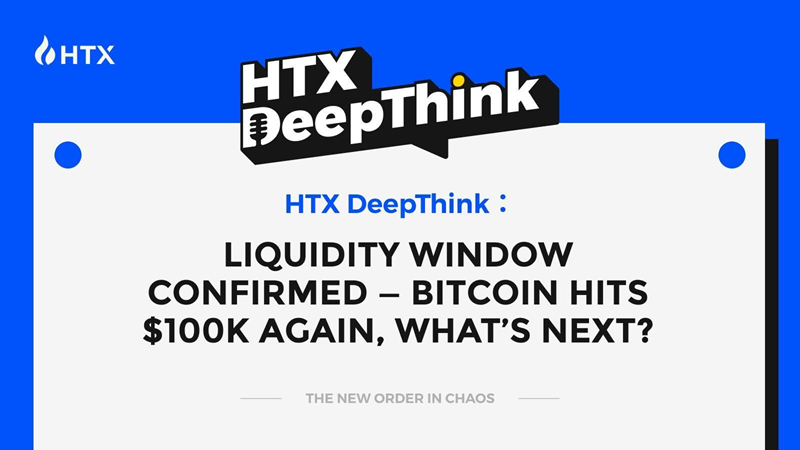HTX DeepThink: Bitcoin Enters New Value Zone – What Will Drive the Market in Q2?

HTX DeepThink is HTX’s strategic information column, which analyzes macro dynamics, global policies, and major shifts affecting the digital asset industry. In a cycle where turbulence is the norm, HTX DeepThink aims to “Find Order in Chaos”.
Bitcoin Stabilizes Above $100,000 – What’s Shaping the New Accumulation Phase?
On May 8, Bitcoin officially crossed the $100,000 mark after three months of trading sideways in the $85,000–$95,000 range, confirming the prediction of Chloe from HTX Research of the “early May liquidity window”. However, it is not just the price that is worth paying attention to, but the cash flow structure behind it.
In the past three weeks, net inflows into U.S. spot Bitcoin ETFs have exceeded $5.3 billion, the largest since the products launched in early 2024. Unlike previous surges that were driven by high leverage and speculative activity, this time the inflows came from large institutional entities, such as the UAE sovereign wealth fund, the Swiss National Bank, and BlackRock.
Policy boost from the US-UK deal: Signals from geopolitics
Also on May 8, the US and the UK reached a historic trade deal, in which the US reduced tariffs on British steel and aluminum to 0%, and the UK opened its agricultural market to American businesses. Although the direct impact on GDP is small, the agreement sends a strong signal: the US is ready to expand trade cooperation after years of policy retreat.
US Commerce Secretary Lutnick hinted that the next trade deal could come from a major Asian economy, raising expectations of a “soft policy push” – a factor that has traditionally been supportive of risk assets like cryptocurrencies.
From Speculation to Long-Term Positioning: Bitcoin Becomes a ‘Super-Sovereign Asset’
Global financial institutions starting to view Bitcoin as part of their long-term portfolios rather than a speculative instrument has created a structural shift in how BTC is valued. With the US 10-year Treasury yield anchored below 4.60% and Bitcoin’s implied volatility (IV) holding steady in the 50%–55% range, the market is showing maturity.
Leverage remains under control as CME futures open interest stands at just $14.8 billion – nearly 30% below its 2020 peak. Bitcoin is currently consolidating in the $105,000-$115,000 range, preparing for the next economic boost.
Macro variable to watch: Trade war risk
Despite the positive outlook, geopolitical risks cannot be overlooked. Negotiations between the US, China and the EU are at an impasse. President Trump has vowed to maintain the 145% tariff on Chinese goods if re-elected, while the EU has also prepared a list of US goods worth up to 100 billion euros to impose retaliatory tariffs if negotiations fail.
The breakdown of these diplomatic efforts could reignite global tariff wars – a negative catalyst for investor sentiment and risk asset markets, including Bitcoin.
Conclusion: Bitcoin is transforming into a new asset class in global portfolios
If institutional money continues to stabilize and macro policies do not reverse sharply, Bitcoin could enter a long-term accumulation cycle in the six-digit price range – something unprecedented in history. As economic fundamentals gradually shift to a new order, BTC may no longer be just a digital asset – but represent a “non-state standard of value” in the digital financial era.
The content in this article does not constitute investment advice and does not represent the official opinion of any financial institution.
About HTX Research
HTX Research is the in-depth research unit of HTX Group, specializing in analyzing and providing strategic assessments on digital asset markets, blockchain technology and emerging global investment trends.
